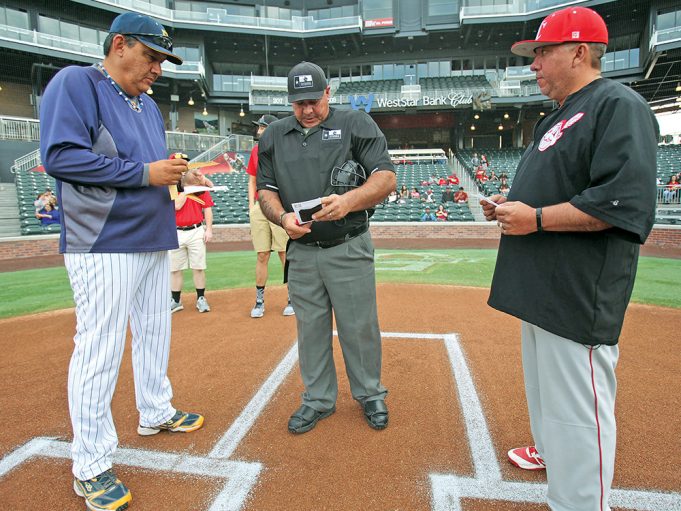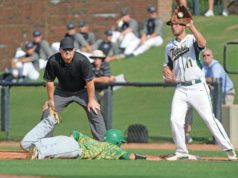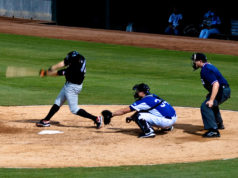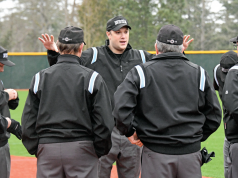The NFHS Baseball Rules Committee opted for just one rule change during its annual meeting in June in Indianapolis. But it is significant and will require a deep dive by high school umpires to consider all of its ramifications during the 2020 season.
The rule change, related to the use of the designated hitter, was subsequently approved by the NFHS board of directors and made public in late June.
Referee created play examples to help illustrate the new rules. Check NFHS publications for official rules language, references and interpretations.
Designated Hitter (3-1-4b)
The change to rule 3-1-4 provides an extra scenario in which a designated hitter may be used. The starting designated hitter may now also be a starting defensive player as listed in the starting lineup presented to the opposing team and the umpire during the pregame plate meeting.
Teams that utilize this option will have one player in the lineup listed with two positions: one of the nine defensive positions and designated hitter. This may include any of the nine defensive positions on the field and is not confined to just the pitcher. Teams using this scenario would begin the game with a lineup featuring nine starters — nine defensive players, one of whom is also the designated hitter.
This differs from the traditional use of the designated hitter at the NFHS level. In that scenario, which remains an option, the designated hitter is listed as a 10th starter who hits for any one of the nine starting defensive players.
Teams also still have the option of not using a designated hitter and batting a straight lineup of nine players.
Where things get a bit tricky with the new designated hitter implementation is with substitutions. The role of the defensive player in this dual role may be substituted for by any legal substitute. Once that occurs, the original player/designated hitter may re-enter as a defensive player one time.
However, the role of the designated hitter is terminated for the remainder of the game when a substitute or former substitute for the defensive role subsequently participates in an offensive role, or the starting defensive player/designated hitter is substituted for either as a hitter or runner. This is a major difference with the traditional designated hitter scenario, in which a substitute may replace the designated hitter as a hitter or runner, and the designated hitter may re-enter the lineup one time and maintain his designated hitter status.
The two available designated hitter options are also a point of emphasis for the 2020 season.
Play 1: Team A lists Daniels as the starting designated hitter and the starting first baseman in the No. 4 position in the lineup. Ruling 1: This is legal, as a player can now be listed on the starting lineup as one of the nine defensive positions and a designated hitter.
Play 2: Team A lists Daniels as the starting designated hitter and the starting first baseman in the No. 4 position in the lineup. In the fourth inning, Jackson substitutes as the first baseman. In the fifth inning, Daniels comes to bat in the No. 4 position.
In the sixth inning, Daniels re-enters defensively as the first baseman. Ruling 2: This is legal, as the role of the defensive player has been substituted by a legal substitute, while the designated hitter role remains intact. The original defensive player/ designated hitter is also allowed one re-entry on defense.
Play 3: Team A lists Daniels as the starting designated hitter and the starting first baseman in the No. 4 position in the lineup. In the fourth inning, Jackson substitutes as the first baseman. In the fifth inning, Jackson comes to bat in the No. 4 position. Ruling 3: This is legal, and the role of the designated hitter is terminated for the remainder of the game. However, Daniels still has re-entry rights, may re-enter at any defensive position and may replace Jackson as the No. 4 hitter in the lineup.
Play 4: Team A lists Daniels as the starting designated hitter and the starting first baseman in the No. 4 position in the lineup. In the top of the fifth inning, Daniels hits a single, and Jackson substitutes for him as a pinchrunner. In the bottom of the fifth inning, Daniels continues to play first base on defense. In the sixth inning, Daniels comes to bat again in the No. 4 position. Ruling 4: This is legal. Once Jackson entered as an offensive substitute for Daniels, the role of the designated hitter is terminated. However, Daniels still has re-entry rights, may re-enter at any defensive position and may replace Jackson as the No. 4 hitter in the lineup.
Play 5: Team A lists Daniels as the starting designated hitter in the No. 4 position in the lineup, and Jackson as the starting first baseman in the No. 10 position. Ruling 5: This is legal, as the designated hitter may still be a 10th starter hitting for any one of the nine starting defensive players.
Play 6: Team A lists Daniels as the starting designated hitter in the No. 4 position in the lineup, and Jackson as the starting first baseman in the No. 10 position. In the fifth inning, Jackson comes to bat in the No. 4 position. Ruling 6: This is legal. Jackson is allowed to pinch-hit, and the role of the designated hitter is terminated for the remainder of the game.
Play 7 : Team A lists Daniels as the starting designated hitter in the No. 4 position in the lineup, and Jackson as the starting first baseman in the No. 10 position. In the fifth inning, Daniels replaces Jackson as the first baseman. Ruling 7: This is legal. Daniels is allowed to play a defensive position, and the role of the designated hitter is terminated for the remainder of the game. However, Jackson still has re-entry rights as a starter and may either pinch-hit or pinch-run for Daniels, and may also re-enter on defense.
Points of Emphasis
Game-ending procedures. The manner in which games are ended, including suspended games, is up to state association adoption. If a state association has adopted such procedures, such as ending a game after five innings if one team has a 10-run lead, only those game-ending procedures may be used. If a state association has not adopted such procedures, a game may be ended, shortened or terminated by mutual agreement of the opposing coaches and the umpire-in-chief.
Force-play slide rule.
Runners arenever required to slide, but if a runner elects to slide, it must be legal. A legal slide can either be feet first or head first. If a runner slides feet first, at least one leg and buttock shall be on the ground. Runners may not pop-up into a fielder, have a leg raised higher than the fielder’s knee, slide away from a base in the direction of a fielder, or slide through or beyond the base, except at home plate. A runner may slide or run in a direction away from the fielder to avoid making contact or altering the play of the fielder. The runner is out when he illegally slides and affects the play, and on a force play, the runner is also guilty of interference.
Compliance of player’s equipment.
The ball and the catcher’s body/ chest protector shall meet the current NOCSAE standards for baseball effective Jan. 1, 2020. Helmets must meet the provisions of rule 1-5-1,
including that all facemasks/guard attached after manufacture are approved by the manufacturer and meet NOCASE standards at the time of manufacture. Bats shall be unaltered from the manufacturer’s original design and production and must meet the provisions of rule 1-3-2.
Proper pitching positions.
The windup and set are the two legal pitching positions. For the windup, the pitcher’s non-pivot foot shall be in any position on or behind a line extending through the front edge of the pitcher’s plate. For the set position, a pitcher shall stand with his entire non-pivot foot in front of a line extending through the front edge of the pitcher’s plate and with his entire pivot foot in contactwith or directly in front of and parallel to the pitcher’s plate. Pitchers are no longer required to have their entire pivot foot in contact with the pitcher’s plate. The so-called hybrid stance remains illegal as it does not meet the requirements of either the windup or set positions. Also, while in the set position, pitchers may dangle their arm in front, but may not rock their arm from side to side. Any such movement
of the arm is considered the start of the
pitching motion and the ball must be
delivered to the plate. Therefore, that
motion results in a balk.
Enforcement of NFHS jewelry rule.
Jewelry, including necklaces, bracelets and earrings, shall not be worn except for religious or medical medals. A religious medal must be taped and worn under the uniform. A medical alert must be taped and may be visible.
What's Your Call? Leave a Comment:
Note: This article is archival in nature. Rules, interpretations, mechanics, philosophies and other information may or may not be correct for the current year.
This article is the copyright of ©Referee Enterprises, Inc., and may not be republished in whole or in part online, in print or in any capacity without expressed written permission from Referee. The article is made available for educational use by individuals.



















